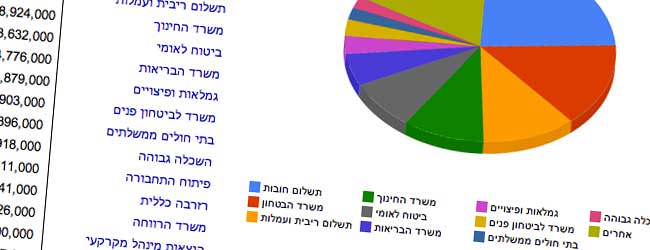
At the end of 2010, after the large Carmel fire, we tried to understand the truth behind the accusations between The Fire and Rescue Services and the Ministry of Finance. Budget was the main issue of contention. The Fire and Rescue Services argued that they weren’t allocated the proper amount of money and the Government claimed otherwise. We felt the claims could be easily verified or refuted given that the state budget books are publicly accessible online. It seemed like a simple inquiry. Turns out, we were really wrong…
A search on the Finance Ministry website revealed that the budget was posted on three different places on the site. The first consisted of 15 excel files, one for each year. In another location, there were enormous text files, some of them describing a single year and others only specific clauses from a single year. The third location was an automatic parliamentary question system that can be used to search and receive a small number of clauses.
Surprisingly, each location presented different numbers for each clause!
After consulting an expert economist, we understood that the budget is divided into a hierarchical order, that each clause has net and gross values (that define the portion of each ministry budget that is conditioned upon external revenue) and that there is significance to the planned values (that are approved by the Knesset), the updated values (following changes during the year through the Finance Committee), and the actual performance (the amount of money really spent).
The sad conclusion was that the planned budget – it was the 2011-2012 budget at the time – is completely inaccessible online (except for a very general description). With the help of Minister Michael Eitan and his team we received, as a precedent, the detailed planned budget (sounds strange, but true…).
The first action we took was to unite all this information in one API accessible database. For the first time ever, now all the budget data from 1992 to 2012 is available online for anyone interested, including all values for a specific clause over the years.
In the second phase, we created a user-friendly website that enables anyone to pull and explore the data even if they aren’t a software developer. We developed and launched the site in March 2011 (again) with the help of Minister Michael Eitan’s staff who also allowed the site to be part of the Israeli Government Portal under the name: budget.msh.gov.il.
Already, the site has serviced a variety of institutions, authorities and civil society associations since it was launched and it has enriched the public discourse on the issue of the budget – with the data open, it’s now easier to contend with demagogy and false arguments.
Among the system users are:
- The Knesset Research and Information Center
- The Research Division of the Bank of Israel
- The budget planning units in the various government ministries
- Financial journalists
- NGOs
- Social activists
And, of course, many citizens who are interested in better understanding the division of resources in the state.
That it is now possible for the Israeli public to view and investigate state and local budgets is vital for the ability of citizens to inspect governing authorities and for a public sense of involvement in government institutions.
The Workshop is actively developing the next version of the Open Budget site in cooperation with Minister Michael Eitan, Tel-Aviv University, Shatil organization, and the Israeli Internet Association. This improved website will include:
- Enhanced visual imaging
- Better search options
- Social features that will allow discussion and sharing
- Expansion of the database to encompass budgets of local authorities, corporations, government companies and more.
In addition, a separate system is being developed with the objective of enabling researchers and professionals to perform in-depth research and to accumulate insights that exceed the raw data.
Our aim is that this system will serve as a major tool for all professional institutions to conveniently analyze state and local budgets, that it will facilitate sharing of information and form a joint knowledge base and that it will eventually provide the general public with a clearer picture of what their tax money is used for.

